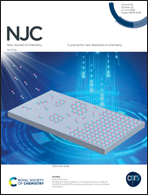A density functional theory study on the strain modulated electronic and photocatalytic properties of a GaSe monolayer for photocatalytic water splitting and artificial photosynthesis†
Abstract
The approach of artificial photosynthesis involves the use of water and sunlight to achieve the photoreduction of CO2 into carbohydrates. Herein, the GaSe monolayer is investigated in terms of its structural, electronic and photocatalytic properties via first-principles calculations towards water splitting and artificial photosynthesis. The mechanical and dynamical stability of the GaSe monolayer was affirmed according to the Born–Huang mechanical stability conditions and phonon band structure, respectively. The GaSe monolayer has an indirect bandgap value of 2.92 eV, with band edges that straddle the water redox and CO2 reduction potentials. Consequently, the GaSe monolayer is a potential photocatalyst for water splitting and CO2 photoreduction over a wide pH range of 0–14. Moreover, a high electron and hole mobility was obtained, which is more significant compared to a 2D MoS2 monolayer. To improve its photocatalytic performance, the GaSe monolayer was investigated in-depth under biaxial tensile and compressive strain. Interestingly, the optimum strain values for water splitting and CO2 photoreductions are 5% and 4%, respectively, owing to their band edges in the vicinity of the redox potentials. Moreover, the GaSe monolayer under 3% tensile strain has a Gibb's free energy for hydrogen adsorption (ΔGH) value of close to 0 eV, making it a promising photocatalyst for hydrogen evolution reaction (HER) activity. Moreover, the strain-induced monolayers have absorption coefficients on the order of 105 cm−1, making the material a potential candidate for solar energy harvesting. Our study suggests that the effect of biaxial strain on these types of transition metal monochalcogenides can be explored experimentally to develop an excellent photocatalyst for use in photocatalytic water splitting and artificial photosynthesis applications.



 Please wait while we load your content...
Please wait while we load your content...